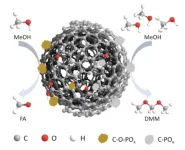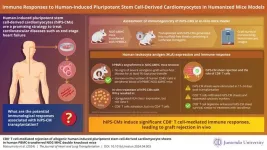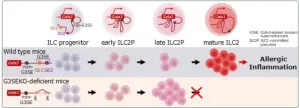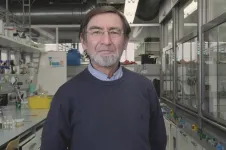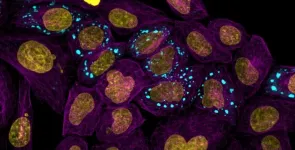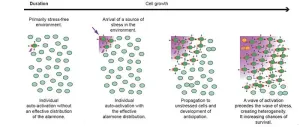(Press-News.org)
Vehicle exhaust from fossil fuel combustion constitutes a main source of air pollutants like carbon dioxide and carbon monoxide. To mitigate air pollution, researchers are looking into additive to fuels like dimethoxymethane (DMM). But DMM production brings its own environmental hazards.
In their paper published June 21 in Carbon Future, a Chinese research team demonstrated how a series of phosphorous-modified nanocarbon catalysts could advance green DMM production.
Unique fuel properties of this diesel blend fuel include high oxygen content and chemical stability as well as low toxicity. A blend of DMM and conventional diesel fuels has been shown to reduce soot formation by as much as 80%.
Commercially, DMM is produced via an established two step-process of methanol oxidation forming formaldehyde, followed by coupling with methanol. However, this conventional synthetic route is complex and environmentally unfriendly due to the complicated sequenced reactions and the use of hazardous acidic catalysts.
To overcome these drawbacks, researchers have been exploring alternative methods to produce DMM. In one promising route, the use of non-metallic nanocarbon materials as catalyst enables the production of DMM in one step.
Non-metallic nanocarbon-based catalysts have emerged in recent years as sustainable, reliable alternatives to the metal catalysts that have traditionally been used as supports in chemical reactions.
“One-step synthesis of DMM via selective oxidation of methanol under the catalysis of nanocarbon is a green and sustainable but challenging chemical process,” said Wei Qi from the University of Science and Technology of China. “Nanocarbon materials have demonstrated notable activity and stability in various catalytic reactions.”
However, achieving one-step synthesis of DMM via methanol conversion requires striking a delicate balance between redox (oxidation-reduction reaction) and acid sites, and there are still many unanswered questions regarding nano carbon catalysts.
For instance, the performance of nanocarbon materials is significantly influenced by functional groups on the surface — but, so far, nanocarbon materials exhibit uncontrollable surface functional groups, which complicates the identification of active sites for different types of reactions.
Recent studies have shown how modifying nanocarbons with nonmetallic heteroatom can effectively adjust surface characteristics and redox/acidic catalytic activity to achieve highly efficient and selective DMM synthetic routes.
Expanding on this line of research, the Chinese research team prepared a series of phosphorus-modified carbon catalysts for the one-step synthesis of DMM from methanol.
With this approach, the team achieved high methanol conversion and DMM formation rate simultaneously.
Through extensive characterization and corresponding control experiments, their research revealed that the covalent linkage of phosphorus and nanocarbon (namely a bond where a carbon atom and a phosphorus atom share a pair of electrons) is a key factor contributing to high DMM selectivity, which indicates efficiency and precision with a catalyst converts raw materials into the fuel additive products.
“This work provided not only a novel and sustainable carbon-based catalyst for the one step synthesis of DMM but also deep insights into the rational design of nanocarbon catalyst for related reaction system,” Qi said.
Their publication provided a new idea for the design of novel nanocarbon materials as well as a potential green catalyst for the efficient selective conversion of methanol to DMM.
The research was supported by the natural Science Foundation of Liaoning province of China, China Baowu Low Carbon Metallurgy Innovation Foundation and Shccig-Qinling program.
Other contributors include Xueya Dai, Pengqiang Yan, Yunli Bai and Miao Guo from the Institute of Metal Research at the Chinese Academy of Sciences. Dai and Bai are also associated with the University of Science and Technology of China.
About Carbon Future
Carbon Future is an open access, peer-reviewed and international interdisciplinary journal, published by Tsinghua University Press and exclusively available via SciOpen. Carbon Future reports carbon-related materials and processes, including catalysis, energy conversion and storage, as well as low carbon emission process and engineering. Carbon Future will publish Research Articles, Reviews, Minireviews, Highlights, Perspectives, and News and Views from all aspects concerned with carbon. Carbon Future will publish articles that focus on, but not limited to, the following areas: carbon-related or -derived materials, carbon-related catalysis and fundamentals, low carbon-related energy conversion and storage, low carbon emission chemical processes.
About SciOpen
SciOpen is a professional open access resource for discovery of scientific and technical content published by the Tsinghua University Press and its publishing partners, providing the scholarly publishing community with innovative technology and market-leading capabilities. SciOpen provides end-to-end services across manuscript submission, peer review, content hosting, analytics, and identity management and expert advice to ensure each journal’s development by offering a range of options across all functions as Journal Layout, Production Services, Editorial Services, Marketing and Promotions, Online Functionality, etc. By digitalizing the publishing process, SciOpen widens the reach, deepens the impact, and accelerates the exchange of ideas.
END
FROM: James Urton
(Note: researcher contact information at the end)
Humans drove wolves to extinction in Washington state around the 1930s. Thanks to conservation efforts, by about 80 years later, wolves had returned — crossing first from the Canadian border into Washington around 2008 and later entering the state from Idaho. Since then, wolf numbers in Washington have been steadily growing, raising questions about what the return of this large predator species means for ecosystems and people alike.
In northeast Washington, where wolves have recovered most successfully, researchers from the University of Washington and the Washington Department ...
The Moon’s recent discovery of energy resources, such as water ice, has refocused interest on its potential as a sustainable hub for space exploration. NASA has also announced the Artemis mission, aiming for long-term human presence on the lunar surface. However, infrastructure expansion, such as lunar base construction plays a vital role.
Yet, transporting construction materials from Earth to the lunar surface via landers incurs a significant cost of 1.2 million USD per kilogram. Weight directly translates to cost, making the transportation of construction materials from Earth to the Moon nearly impossible.
To solve this problem, Korea ...
A smartphone’s unique Bluetooth fingerprint could be used to track the device’s user–until now. A team of researchers have developed a simple firmware update that can completely hide the Bluetooth fingerprint, eliminating the vulnerability.
The method was developed by a team of researchers at the University of California San Diego. The team discovered the vulnerability caused by Bluetooth fingerprints in a study they presented at the 2022 IEEE Security & Privacy conference. They presented the fix to this vulnerability two years later at the 2024 IEEE Security & Privacy conference. The math behind the update itself is complex but the implementation ...
Ischemic heart disease stands as a significant global cause of morbidity and mortality. One promising avenue for treatment involves human induced pluripotent stem cell-derived cardiomyocytes (hiPS-CMs). Derived from adult somatic cells such as blood or skin cells, hiPS cells possess the capacity to differentiate into various tissues, including cardiomyocytes. These cells can potentially repair damaged heart tissue, but their clinical application is limited due to concerns about immune rejection. Understanding the immunogenicity of hiPS-CMs is crucial for advancing their ...
Overproduction of Group 2 innate lymphoid cells or ILC2s—a type of white blood cells—can sometimes exacerbate conditions such as bronchial asthma, chronic rhinosinusitis, atopic dermatitis, and organ fibrosis through an exaggerated immune response. Although there are immunomodulatory drugs that can suppress Type 2 helper T (Th2) cells, drugs capable of suppressing ILC2s are currently lacking.
Now, however, in a breakthrough study that could lead to the development of a new therapeutic strategy targeting ILC2s, researchers led by Associate Professor Arifumi Iwata of the Chiba University Hospital, Japan, have identified molecular ...
The Specialised Group on Chemistry of Natural Products (GQPN) of the Spanish Royal Society of Chemistry (RSEQ) has awarded its Excellence in Research Award 2023 to Professor Ricardo Riguera. The Evaluation Committee thus recognises his valuable contribution to this area of chemistry. Among other advances, his work has made it possible to describe a large number of bioactive metabolites, such as the first heptacyclopeptide and the first cyclodepsipeptide isolated from marine organisms. Riguera also identified one of the first examples of cytotoxic metabolites from marine bacteria, the first description of L-galactose as part of a natural product, and the first description ...
FINDINGS
A UCLA-led team has developed a machine-learning model that can predict with a high degree of accuracy the short-term survival of dialysis patients on Continuous Renal Replacement Therapy (CRRT).
BACKGROUND
CRRT is a therapy used for very sick hospitalized patients whose health status makes them ineligible for regular hemodialysis. It is a gentler therapy that provides continuous treatment over a prolonged period. About half of adults placed on CRRT, however, do not survive, rendering the treatment futile for both patients ...
Poverty and mental illness are not only linked, but there is also a causal relationship. This is the conclusion of researchers from Amsterdam UMC, the University of Edinburgh and the University of Modena. Their study shows that while certain mental health issues can hinder financial stability, poverty is also one of the causal factors leading to mental health problems. This study was published today in Nature Human Behaviour.
"This study indicates that certain mental health problems can make a person's financial situation uncertain. But conversely, we also see that poverty can lead to mental health problems," ...
Scientists at the University of Cambridge have developed an atlas of proteins describing how they behave inside human cells. This tool could be used to search for the origins of diseases which are related to proteins misbehaving such as dementia and many cancers.
The atlas, which is published in Nature Communications, has allowed the researchers to find new proteins inside cells that are responsible for a range of important bodily functions. The team focuses on a droplet-like part of the cell called a condensate ...
When confronted with an antibiotic, toxic substance, or other source of considerable stress, bacteria are able to activate a defence mechanism using cell-to-cell communication to ‘warn’ unaffected bacteria, which can then anticipate, shield themselves and spread the warning signal. This mechanism1 has just been described for the first time by a team of scientists2 from CNRS and Université de Toulouse III – Paul Sabatier. It paves the way for the development of new, more effective antibiotic treatments that can target this bacterial communication system.
When they perceive a source of stress, bacteria spring into action, inducing changes in the expression of certain ...
